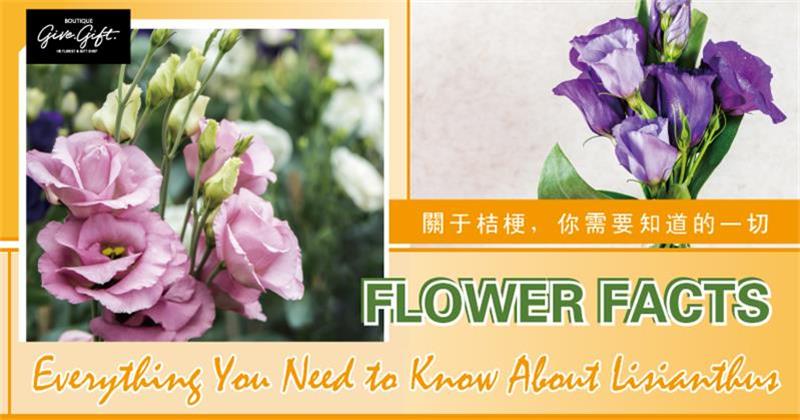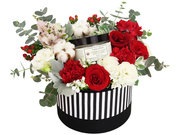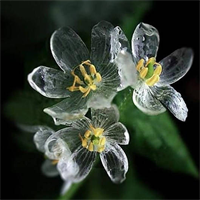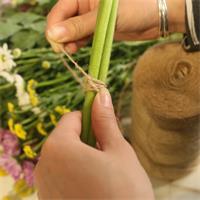The beloved lisianthus, also known as eustoma, is a vibrant and versatile flower that is enjoyed by florists, flower lovers, and gardeners everywhere. Lisianthus is a beautiful flower with velvety soft and delicate oval petals in a lovely bell-shaped bloom. Lisianthus is easy to recognise with its long stems, blue-green leaves, and multiple blooms. Lisianthus can grow as a single or double bloom and can range from big to small in size. It’s single blooms look similar to tulips or poppies while its double blooms look like roses or peonies. Lisianthus is derived from the Greek words Lysis, which means dissolution, and Anthos which means flower. Eustoma derives from its scientific name Eustoma Grandiflorum.
Scientific Information of Lisianthus
How Do You Pronounce Lisianthus?
lizzie-ANN-thus
Origins
Lisianthus, or eustoma, is a genus of three species in the family Gentianaceae. The small genus consists of Eustoma exaltatum, Eustoma barkleyi and Eustoma russellianum. The lisianthus is an annual plant that generally grow to around 15–60 cm tall with some variation within the species.
History of Lisianthus
While native to North America it was the Japanese in the 1930s that cultivated and created the lisianthus we know today. From the 1930s, the lisianthus was popular in horticulture but it wasn’t until the 1980s when it was adapted for the cut flower world. Fairly new to the floristry world, the lisianthus has quickly become a florist favourite for its large, rainbow blooms. Before that, lisianthus was also used by the Victorians and used to symbolise a showy or flashy individual. Lisianthus’ Greek name also alludes to the flower’s bitter taste, as lisianthus was previously used in some herbal medicines.
Lisianthus Colours
Lisianthus comes in a wide array of colours, some of which are even picotee, meaning the tips of the petals are a different colour than its base. Its petals can also be smooth or fringed but always retain its soft and delicate texture. Shape and colour varieties are still being discovered, so its current colour varieties include but aren’t limited to:
• White
• Green
• Blue
• Pink
• Purple
• Yellow
• Lilac
• Lavender
• Salmon
• Apricot
• Champagne
Common Lisianthus Types
Eustoma russellianum
The most common species of lisianthus. It’s this species that you’ll find in most cut flowers. In its native habitat, it is also known as a Texas bluebell, Lira de San Pedro, tulip gentian or the prairie gentian.
Eustoma exaltatum
Slso known as the seaside gentian, is a species of lisianthus whose natural habitat is in wet areas like stream beds, salty coastal areas or alkaline marshes. The seaside gentian is moderately tolerant to saltwater and it very tolerant to salty winds.
Within these species, there are around 25 or more different cultivated varieties of lisianthus. In terms of horticulture, lisianthus is placed in groups from 0 to 4 based on how early the flower blooms, with 0 being the earliest and 4 being the latest.
Here are some of the most prominent cut flower varieties.
Echo
Also known as the Dream type, is a group 1 lisianthus, meaning it flowers early. Echo was the very first cut double flower lisianthus type. The echo type has large flower blooms and sturdy stalks to support them. Echo comes in the colours, purple, lavender, pink, champagne, pink picotee, white and yellow.
Rosita
While the Echo may have been the first cut double bloom, the Rosita is now the industry standard when it comes to the double blooming lisianthus. The Rosita blooms in groups 1, 2, 3, and 4 and has masses of rose-like blooms on thick sturdy stems. The blooms are of medium size and have exceptional vase life. It also has an extensive array of colour varieties. The hardiness of this lisianthus type, as well as its appearance, make it very popular in flower arrangements.
Excalibur
This type of lisianthus was cultivated so that it could grow in areas where the temperature is higher. It is considered a group 2 or 3 types and has medium-sized blooms. As a cut flower, Excalibur has an excellent vase life. It comes in white, green, blue picotee, pink, and yellow.
Piccolo
This is the most popular type of single bloom lisianthus. It groups in 1, 2, and 3 in terms of when it blooms and has a wide colour range including some stunning picotee varieties. The piccolo lisianthus is a sturdy flower with a long vase life making it popular with florists.
Alissa
A large double bloom lisianthus with fringed petals, this type of lisianthus is the perfect balance of strength and beauty. It blooms in groups 1 and 2, striking a nice balance. The flowers of the Alissa are large, well-filled, and hardened making them less likely to get damaged in a flower arrangement. Along with its sturdy stems and long vase life, it comes in wonderful shades of green, champagne, light apricot, pink, white, yellow, and blue making the Alissa another consumer and florist favourite.
Mariachi
The Mariachi contains quadruple blooms, making them quite exceptional. They have a balanced bloom period in group 2 and its bloom size grows between 5-7cms and has a camellia-like appearance. It comes in an array of colours, including a shade of misty blue.
Lisianthus Symbolism
Lisianthus has robust symbolism. It can exemplify gratitude and appreciation when given as a gift. It has also been associated with congeniality, charisma, and feelings of romantic desire. As it has roots as a prairie flower, it is also indicative of traditional or old-fashioned values, as well as receptivity, and calm thoughts.
Lisianthus Flower Arrangements
With such rich symbolism and colour variety, lisianthus flowers make stunning flower arrangements. They have soft, sweet and delicate appearance making them popular in ‘thank you’ arrangements as well as in wedding arrangements, wedding centrepieces, corsages, and bridal bouquets. The lisianthus can hold the centre stage in a flower bouquet but also pairs exceptionally well with flowers of similar sizes, such as roses, hyacinths, carnations, and lilies. The long and sturdy stems of the lisianthus make them ideal flower bouquets and lend themselves well to the French style of flower arranging.
Related: What Are French Designed Flower Bouquets?
Lisianthus Care
Lisianthus is known to be tricky to grow and requires some maintenance. Most varieties of cut lisianthus have a good vase life but are still particularly delicate.
Garden Care
If you’re planting lisianthus from seeds it is important to note that the seeds much be sown on the surface of the soil and not be buried. Lisianthus prefers slightly acidic soil that should always be kept moist but also well-drained.
Further, if propagating outside, lisianthus should be done in a warm environment and planted in the late spring once all the year’s frosts are done. Lisianthus is extremely susceptible to frost. Lisianthus makes for ideal indoor plants for this reason as they prefer temperatures around 16-24°C.
If growing the lisianthus inside, give it a light spot but keep out of direct sunlight with low humidity.
Cut Lisianthus Flower Care
With proper care, a lisianthus flower arrangement can last up to two weeks. When purchasing lisianthus it’s important to make sure that at least one flower is open on each stem and to avoid any arrangements that have yellowing leaves.
General Flower Care
• Cut the stems at a 45-degree angle.
• Use flower food.
• Prune and remove any dead or dying leaves or petals, especially if they’ve fallen in the water.
• Change the water daily.
• Keep flowers away from drafts, fans, and appliances that give off heat.
Lisianthus is extremely bacterial-sensitive making it very important to ensure you have a clean vase to start with and to change its water often to prolong the arrangement’s longevity. In placing the flowers, keep them out of direct sunlight and avoid humid areas.
Related: How to Make Your Flowers Last Longer
More Facts About Lisianthus
• Eustoma grandiflorum used to be called Lisianthus russellianus.
• Single blooms of lisianthus resemble tulips or poppies.
• Double blooms of lisianthus are similar to roses or peonies.
• Lisianthus is the birth flower for Sagittarius.
• Because lisianthus is often difficult for people to pronounce, they are often called Lizzies.
• One of its closest relatives is the Persian violet.
• Eustoma, which is Latin, means “good mouth”. It makes references to the petals of the flower. Whereas Grandiflora means “large flowers” referring to the wide blooms of the lisianthus.
• Lisianthus is geotropic, which just means that if you place or plant the flowers horizontally the will curl upwards toward the sky as they grow.
• Lisianthus is non-toxic to both humans and animals.
• People also name the lisianthus is the Poor Man’s Rose"
















 Share
Share Tweet
Tweet +1
+1  Pin it
Pin it Post
Post  Weibo
Weibo Review
Review



















 Diwali Gifts
Diwali Gifts 
 ▶
▶